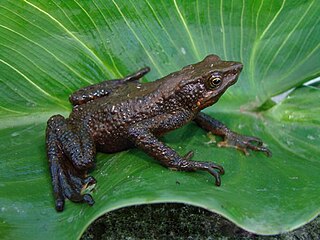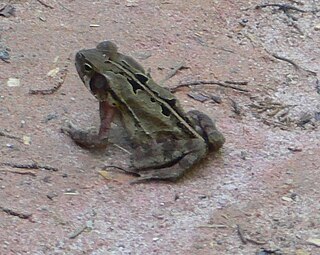
Nectophrynoides poyntoni, also known as Poynton's forest toad, is a species of toad in the family Bufonidae. It is endemic to the Udzungwa Mountains in Tanzania and is only known from its type locality in the Mkalazi Valley. This species is only known from a single collection in 2003 and has not been seen ever since, despite targeted searches. Therefore, it is feared that it has strongly declined and might already be extinct.
Nectophrynoides wendyae, also known as the Uzungwe Scarp tree toad or Wendy's forest toad, is a terrestrial toad in the family Bufonidae. It is endemic to Tanzania and is only known from a single valley in the Udzungwa Mountains. The specific name wendyae honours Wendy Clarke, the describer's wife.
Bufoides kempi is a species of true toad, family Bufonidae. This poorly known species is endemic to Meghalaya, Northeast India. It is only known with certainty from its type series collected "above Tura" at 2,500 ft (760 m) in the Garo Hills no later than 1919; there is also a possible record collected at around 2009. Its common names are Kemp's Asian tree toad, Garo Hills toad, and Garo Hills tree toad. The specific name kempi honours Stanley Wells Kemp, an English zoologist and anthropologist.

Atelopus cruciger, also known as the Veragua stubfoot toad or Rancho Grande harlequin frog, is a species of toad in the family Bufonidae. It is endemic to Venezuela and is known from the central Venezuelan Coastal Range. The species was already suspected to be extinct because, despite considerable effort, none had been found since 1986. However, in 2003, a small population was found, with few other locations discovered later. It is mainly threatened by chytridiomycosis. It is locally called sapito rayado.

Atelopus laetissimus is a species of toad in the family Bufonidae. It is endemic to Colombia and only known from the area of its type locality in the northwestern part of the Sierra Nevada de Santa Marta, in the Magdalena Department.

Atelopus nahumae is a species of toad in the family Bufonidae. It is endemic to Colombia and only known from humid montane forest of Sierra Nevada de Santa Marta in the Magdalena, La Guajira, and Cesar Departments.
Atelopus vogli is an extinct species of harlequin frog in the family Bufonidae. It was endemic to Venezuela. It is known from collections in two localities: its type locality, Las Peñas near Hacienda la Trinidad in Aragua, and Montalbán in Carabobo. It was first described as subspecies of Atelopus cruciger. The specific name vogli honours Cornelius Vogl, German priest who was a missionary in Venezuela in 1925–1959. Common name Vogl's harlequin toad has been coined for it.

Rhinella crucifer is a species of toad in the family Bufonidae. It endemic to Brazil and known from the Atlantic Forest of eastern Brazil between the states of Ceará in the north and Rio de Janeiro in the south. Common name striped toad has been coined for it. "Rhinella pombali" is a hybrid between Rhinella ornata and this species.

Rhinella jimi is a species of toads in the family Bufonidae. It is endemic to northeastern Brazil and known between Bujaru in northeastern Pará and Maranhão in the north, south to Bahia and Vitória, Espírito Santo. Prior to its description in 2002, it was confused with Rhinella schneideri. The specific name jimi honors Jorge Jim, a Brazilian herpetologist. Common name Jimi's toad has been coined for it.
Sclerophrys langanoensis is a species of toad in the family Bufonidae. It is endemic to northern Rift Valley in Ethiopia, where it has been recorded from Lake Langano and the Awash National Park; the latter population might represent a distinct species. It is likely that this species will also be found in Eritrea and Somalia. Common name Lake Langano toad has been coined for it.

Incilius pisinnus is a species of "true" toads in the family Bufonidae. It is endemic to Mexico and known from the Tepalcatepec Valley in Michoacán. Prior to its description in 2005, it was mixed with Incilius coccifer and Incilius cycladen. The specific name pisinnus, from the Latin word for "small", refers to the comparatively small size of this species among its close relatives.
Sclerophrys reesi, also known as Merara toad or Rees' toad, is a species of toad in the family Bufonidae. It is endemic to southern Tanzania and is only known from the Kihansi–Ulanga River floodplain from elevations of 200–500 m (660–1,640 ft) above sea level. It is named after Allen Rees, a principal game warden for the Tanzanian Wildlife Department who collected the type series.
Nectophrynoides laevis, the smooth forest toad, is a species of toad in the family Bufonidae.
Nectophrynoides minutus is a species of toad in the family Bufonidae. It is endemic to Tanzania and is known from the Uluguru and Rubeho Mountains. Common names small viviparous toad, minute tree toad, and dwarf forest toad have been proposed for it.
Nectophrynoides pseudotornieri is a species of toad in the family Bufonidae. It is endemic to the Uluguru Mountains in eastern Tanzania. Common names pseudo forest toad and false Tornier's viviparous toad have been proposed for it. Its specific name refers to its similarity to Nectophrynoides tornieri.
Nectophrynoides viviparus is a species of toad in the family Bufonidae. It is endemic to Tanzania. Common names robust forest toad and Morogoro tree toad have been coined for it.

Rhinella acrolopha, also known as Cerro Mali beaked toad, is a species of toad in the family Bufonidae. It is found in the Serranía del Darién in eastern Panama and in the immediately adjacent northwestern Colombia, in the Los Katíos National Park. The specific name acrolopha is derived from the Greek akrolophos, meaning crest of a mountain or ridge, and refers to the isolated occurrence of this species at high elevations in the Serranía del Darién. However, the International Union for Conservation of Nature (IUCN) characterizes it as a lowland species.
Mertensophryne howelli is a species of toad in the family Bufonidae. It is endemic to the coast of Tanzania and known from the Mafia Island and Zanzibar. The species is named after professor Jim Howell for his contributions to the herpetology of Tanzania.

Nectophrynoides laticeps is a species of toad in the family Bufonidae. It is endemic to the Ukaguru Mountains of Tanzania. Common name wide-headed viviparous toad has been proposed for it.

Rentapia flavomaculata, also known as the yellow-spotted tree toad, is a species of toad in the family Bufonidae. It is endemic to the Malay Peninsula. Before being described as a distinct species in 2020, it was confused with Rentapia hosii.









